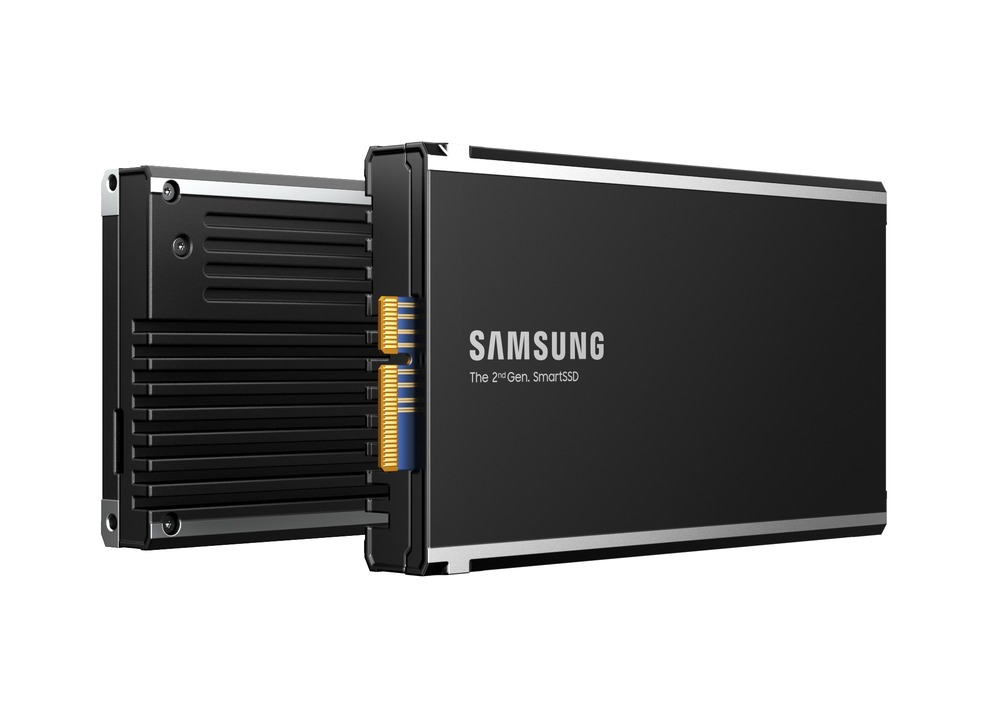Samsung Electronics Develops Second-Generation SmartSSD Computational Storage Drive With Upgraded Processing Functionality
Cuts pro┬Łces┬Łsing time by over 50%, ener┬Łgy con┬Łsump┬Łti┬Łon by up to 70% and CPU uti┬Łliza┬Łti┬Łon by up to 97% com┬Łpared to con┬Łven┬Łtio┬Łnal SSD drives
Sam┬Łsung Elec┬Łtro┬Łnics, the world lea┬Łder in advan┬Łced memo┬Łry tech┬Łno┬Łlo┬Łgy, today announ┬Łced that it has suc┬Łcessful┬Łly deve┬Łlo┬Łped a second gene┬Łra┬Łti┬Łon of its pio┬Łnee┬Łring SmartSSD.
The new pro┬Łprie┬Łta┬Łry com┬Łpu┬Łta┬Łtio┬Łnal sto┬Łrage incor┬Łpo┬Łra┬Łtes data pro┬Łces┬Łsing func┬Łtion┬Ła┬Łli┬Łty within a high-per┬Łfor┬Łmance SSD. Unli┬Łke exis┬Łting SSDs, SamsungŌĆÖs SmartS┬ŁSD can pro┬Łcess data direct┬Łly, ther┬Łeby mini┬Łmi┬Łzing data trans┬Łfers bet┬Łween the CPU, GPU and RAM. This tech┬Łno┬Łlo┬Łgy can avo┬Łid the bot┬Łt┬Łlen┬Łecks that often occur when moving data bet┬Łween sto┬Łrage devices and CPUs, resul┬Łting in mark┬Łed┬Łly impro┬Łved sys┬Łtem per┬Łfor┬Łmance and much hig┬Łher ener┬Łgy efficiency.
The SmartS┬ŁSD is play┬Łing an incre┬Łasing┬Łly important role, espe┬Łci┬Łal┬Łly with the growth of next-gene┬Łra┬Łti┬Łon tech┬Łno┬Łlo┬Łgies such as AI, machi┬Łne lear┬Łning and 5G/6G, which requi┬Łre lar┬Łge amounts of data processing.
Lever┬Łaging soft┬Łware and intellec┬Łtu┬Łal pro┬Łper┬Łty (IP) deve┬Łlo┬Łped by cus┬Łto┬Łmers, along with in-built Arm cores, SamsungŌĆÖs second-gene┬Łra┬Łti┬Łon SmartS┬ŁSD enables much more effi┬Łci┬Łent data pro┬Łces┬Łsing. Com┬Łpared to con┬Łven┬Łtio┬Łnal data cen┬Łter solid-sta┬Łte dri┬Łves, pro┬Łces┬Łsing time for scan-hea┬Łvy data┬Łba┬Łse queries can be slas┬Łhed by over 50%, ener┬Łgy con┬Łsump┬Łti┬Łon by up to 70% and CPU uti┬Łliza┬Łti┬Łon by up to 97%.
Sin┬Łce its deve┬Łlo┬Łp┬Łment in 2020 through the joint efforts of Sam┬Łsung and AMD, the first-gene┬Łra┬Łti┬Łon SmartS┬ŁSD is being sup┬Łpli┬Łed to glo┬Łbal IT com┬Łpa┬Łnies inclu┬Łding video com┬Łmu┬Łni┬Łca┬Łti┬Łons plat┬Łform pro┬Łvi┬Łders. The first-gene┬Łra┬Łti┬Łon SmartS┬ŁSD was reco┬Łgni┬Łzed as an Inno┬Łva┬Łti┬Łon Awards Hono┬Łree at CES 2021 for its out┬Łstan┬Łding per┬Łfor┬Łmance and ener┬Łgy efficiency.
ŌĆ£Com┬Łmer┬Łcia┬Łliza┬Łti┬Łon of the first-gene┬Łra┬Łti┬Łon SmartS┬ŁSD, in col┬Łla┬Łbo┬Łra┬Łti┬Łon with AMD, estab┬Łlished that the com┬Łpu┬Łta┬Łtio┬Łnal sto┬Łrage mar┬Łket has gre┬Łat poten┬Łti┬Łal,ŌĆØ said Jin-Hyeok Choi, Exe┬Łcu┬Łti┬Łve Vice Pre┬Łsi┬Łdent and Head of Memo┬Łry Solu┬Łti┬Łon Pro┬Łduct & Deve┬Łlo┬Łp┬Łment at Sam┬Łsung Elec┬Łtro┬Łnics. ŌĆ£With the upgraded pro┬Łces┬Łsing func┬Łtion┬Ła┬Łli┬Łty of the second-gene┬Łra┬Łti┬Łon SmartS┬ŁSD, Sam┬Łsung will be able to easi┬Łly address incre┬Łasing cus┬Łto┬Łmer needs in the data┬Łba┬Łse and video trans┬Łco┬Łding sec┬Łtors, as we expand the boun┬Łda┬Łries of the next-gene┬Łra┬Łti┬Łon sto┬Łrage market.ŌĆØ
ŌĆ£Powered by Xilinx Ver┬ŁsalŌäó Adap┬Łti┬Łve SoCs from AMD, second-gene┬Łra┬Łti┬Łon Sam┬Łsung SmartS┬ŁS┬ŁDs enable impro┬Łved CPU effi┬Łci┬Łen┬Łcy and great┬Łly redu┬Łced ener┬Łgy con┬Łsump┬Łti┬Łon by effi┬Łci┬Łent┬Łly inte┬Łgra┬Łting the com┬Łpu┬Łting and sto┬Łrage func┬Łtions in data cen┬Łters,ŌĆØ said Sina Sol┬Łta┬Łni, Cor┬Łpo┬Łra┬Łte Vice Pre┬Łsi┬Łdent of Sales, AECG, Data Cen┬Łter and Com┬Łmu┬Łni┬Łca┬Łti┬Łon Group at AMD. ŌĆ£As data-inten┬Łsi┬Łve appli┬Łca┬Łti┬Łons con┬Łti┬Łnue to grow, second-gene┬Łra┬Łti┬Łon Sam┬Łsung SmartS┬ŁS┬ŁDs will deli┬Łver the supe┬Łri┬Łor per┬Łfor┬Łmance and effi┬Łci┬Łen┬Łcy requi┬Łred for this expan┬Łding market.ŌĆØ
Sam┬Łsung Elec┬Łtro┬Łnics is lea┬Łding efforts to stan┬Łdar┬Łdi┬Łze SmartS┬ŁSD tech┬Łno┬Łlo┬Łgy through clo┬Łse col┬Łla┬Łbo┬Łra┬Łti┬Łon with the Sto┬Łrage Net┬Łwor┬Łking Indus┬Łtry Asso┬Łcia┬Łti┬Łon (SNIA) and with NVM Express, while see┬Łking to expand the boun┬Łda┬Łries of SmartS┬ŁSD devices through tech┬Łno┬Łlo┬Łgi┬Łcal vali┬Łda┬Łti┬Łon for a wide varie┬Łty of applications.

